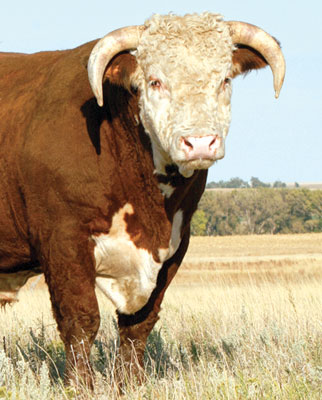 Herd sires need a little extra attention once the breeding season is over
Herd sires need a little extra attention once the breeding season is over
Bulls make up half the genetic material in a cattle operation, so off-season bull health and management is important to protect an investment. However, not all producers need to consider the same off-season management techniques.
There are many factors to consider which they will vary across operations. For instance, young bulls will require additional attention in the off-season compared to mature bulls. With that in mind, there are a few factors that all producers should consider post-breeding season.
Sorting
Generally, at the close of breeding season, bulls should be pulled from the rest of the herd. Separating bulls from the rest of the herd ensures they are kept in moderate body condition and minimizes the chance of injury. The first thing to do post breeding season is determine the body condition score (BCS) and begin sorting bulls, typically, into three different categories. Bulls should be categorized based on maturity and maintenance, age and special requirements (additional quality feed, young bulls, etc.), and cull stock. The cull stock should consist of old or crippled bulls that have completed their reproductive years and need to be removed from the breeding stock. After culling, it’s important to determine the number of bulls an operation will require for the next season and determine a strategy early for replacement.
Feed
Some animal nutritionists recommend a bull be fed 2 percent of its body weight in feedstuffs daily. All bulls should have access to quality mineral mix. Phosphorus is a mineral that is often not found in adequate amounts in dry or harvested forage. Another important vitamin for reproduction is Vitamin A; which is typically found in growing forage or high-quality hay. According to the Noble Research Institute, it is not uncommon for a bull to lose one to one-and-a-half body condition points during a tightly controlled breeding season. For most healthy bulls, this isn’t an issue and they should be able to recover fairly quickly without a lot of supplemental nutrition. However, if it is the first or second breeding season for a young bull then additional supplemental nutrition would likely be required to fully recover. Consider additional supplemental nutrition prior to the first frost of the year. Research indicates that it is far easier to increase BCS in the growing season vs. the winter months. It is recommended to achieve a BCS of 6.5 prior to turnout time in the spring.
Health Management
Bulls should receive immunizations in the off-season. All bulls should receive a viral respiratory complex vaccine booster and they should also receive vaccinations to prevent against Leptospirosis and Vibriosis. It’s also important to ensure that bulls have cover in harsh winter conditions. Frostbite can have extreme effects on bull fertility. Every effort should be made to ensure bulls have protection from extreme temperature situation, including wind chill, to avoid the development of fertility problems. Tissue damage from frostbite is clinically indicated if you notice tissue discoloration, scabs, or sloughing of the lower portion of the scrotum. Contact your vet if you suspect frostbite in your bull herd throughout the severe winter months.
Structural Soundness
When determining structural soundness, start with the head, neck, brisket, shoulders, front legs and feet. Let’s first take a look at the importance of head size. Considering the size of a bulls head and ensuring it is proportionate to their body structure is important to prevent issues with calving. Pay attention to eye placement as well. The eyes should have enough structure above them that the animal has protection from direct sunlight. Eye cancer is an inheritable trait and most commonly related to sunlight exposure and eye placement. Pay attention to muzzle length too. Verify the muzzle is wide enough for grazing and the lower jaw doesn’t protrude too much.
When evaluating the brisket, consider fat deposition. Choose a bull that is trim in the brisket, this helps ensure that the progeny have high-yielding carcass weights.
Choose a bull that has naturally sloping shoulders, around 45 degrees is ideal. Bulls that are too straight or too angled in the front legs may be prone to problems down the road, such as arthritis or wearing of the hooves. When viewed from the front, the legs should be straight from the point of the shoulder, through the knee, to the middle of the claw.
It’s also important to pay attention to their gait, hind legs and feet, and sheath.
Fertility
Bulls should be breeding about one cow per every month of age, between ages 2 and 4, equating to roughly 25 and 40 cows bred per bull during a breeding season. A semen analysis should be performed on bulls about 30 to 60 days prior to breeding season. Not all producers utilize the breeding soundness exam (BSE), especially those with smaller herds; however, it is one of the most effective ways to determine subfertile or infertile bulls and should be utilized, especially for larger operations.



